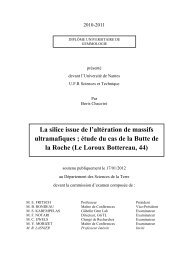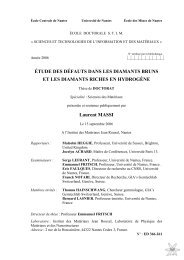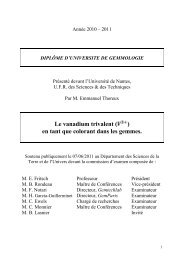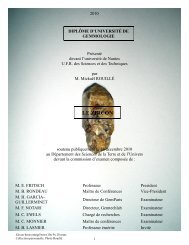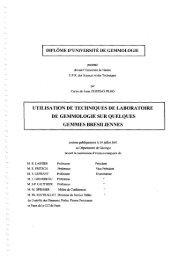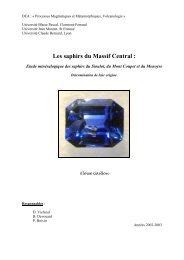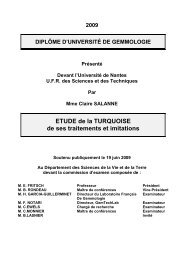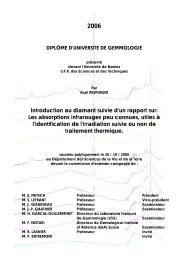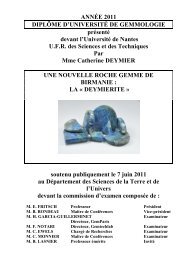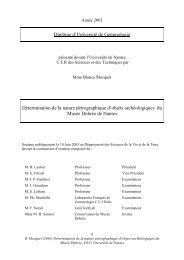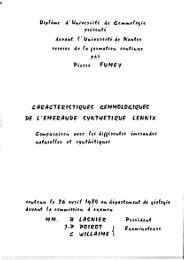Classification of brown diamonds and their color origin - GemNantes
Classification of brown diamonds and their color origin - GemNantes
Classification of brown diamonds and their color origin - GemNantes
You also want an ePaper? Increase the reach of your titles
YUMPU automatically turns print PDFs into web optimized ePapers that Google loves.
4. Correlations <strong>of</strong> the results<br />
A close look at the above results shows that correlations between IR spectra, PL<br />
spectra, <strong>color</strong> distribution, luminescence <strong>and</strong> even inclusions exist. Based on these<br />
correlations, a classification <strong>of</strong> <strong>brown</strong> <strong>diamonds</strong> could be established.<br />
The list below shows the data <strong>of</strong> the analyzed stones. The list is not based on the final<br />
classification but on the initial groups, which were formed mainly by <strong>their</strong><br />
characteristic IR spectra.<br />
We did not take the PL <strong>and</strong> VIS/NIR spectra into consideration when establishing the<br />
list <strong>of</strong> properties. It appears, that the IR spectra are much more important when<br />
classifying these <strong>diamonds</strong>. Thus the IR type plus important IR features were<br />
compared to <strong>color</strong>, <strong>color</strong> distribution, UV-fluorescence/phosphorescence <strong>and</strong><br />
inclusions.<br />
To demonstrate the correlations more visually two photo-tables were designed: In the<br />
first table, the face-up <strong>color</strong> <strong>and</strong> the strain pattern between crossed polarizers <strong>of</strong> 52<br />
selected <strong>diamonds</strong> are shown.<br />
The second table contains photographs <strong>of</strong> the <strong>color</strong> distribution <strong>of</strong> 27 selected<br />
samples (representing all types observed). The <strong>color</strong> distribution was photographed<br />
with the stones immersed in methylene iodide; in this table, pictures <strong>of</strong> characteristic<br />
luminescence patterns <strong>and</strong> inclusions are shown for stones in which these features<br />
appear characteristic.<br />
Additionally, the above features were compared to the luminescent pattern <strong>of</strong> some<br />
stones when they were excited by an electron beam (cathodoluminescence). These<br />
pictures were recorded in black <strong>and</strong> white since the camera in the electron<br />
microscope could not record in <strong>color</strong>.<br />
40



